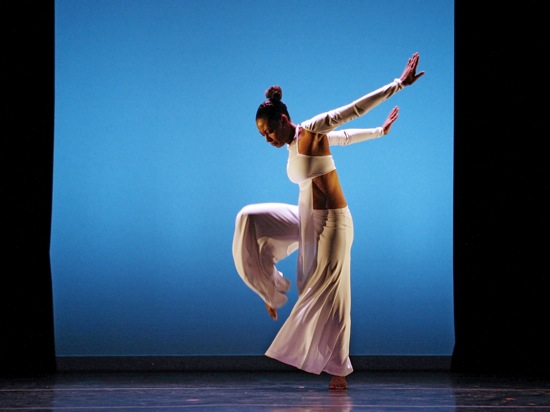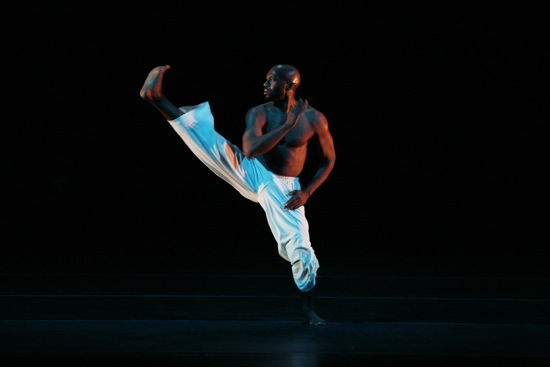Ronald K.Brown celebrates at the Joyce Theater the 30th anniversary of his Evidence: A Dance Company.
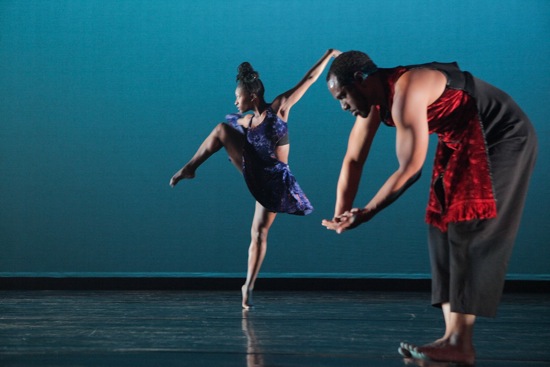
Coral Dolphin (L) and Keon Thoulouis in “Exotica” from Ronald K. Brown’s Lessons. Photo: Ayodele Casel
Sometimes I think of choreographer Ronald K. Brown, the artistic director of Evidence: A Dance Company, as akin to a spiritually inspired basket maker, weaving beautiful strands of dancing together with time-honed skill. These strands mesh in patterns formed by eight passionate, spirited dancers. Beguiling to look at, the designs nevertheless seldom clearly resolve into what for the creator of baskets would be bowls and boxes and screens. It’s often difficult to follow a path through the dance-filled terrain to understand the ideas that Brown is developing.
The most recent piece (2014) that I saw on Program A of his company’s 30th anniversary season at the Joyce Theater is titled The Subtle One, a sobriquet attached to Al-Lateef, a manifestation of Allah. The program offers another vision of subtlety in the last stanza of a poem by Alan Harris: “So subtle are the wings of angels/That you may not realize/They’ve come and gone, except/That innerly remains a glowing/Which seems just as/good as knowing.”
Spirituality infuses almost every dance of Brown’s that I have seen. He choreographs community, and the dancing can easily stand for spiritual practice—committed, body and soul; laboring in its biblical sense—as in, laboring in the fields of the Lord. That community can also refer to African Americans, marching for equality on this earth.
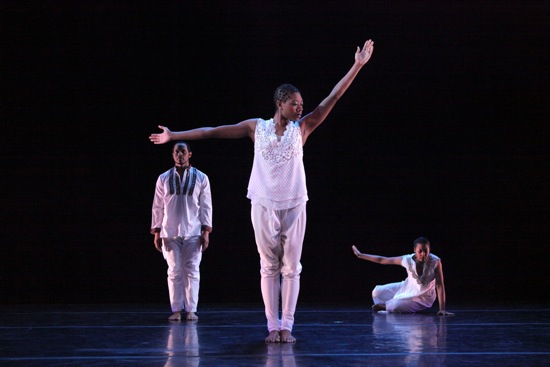
(L to R): Keon Thoulouis, Brionna Edmundson, and Clarice Young in Ronald K. Brown’s The Subtle One. Photo: Ayodele Casel
The venturesome jazz score for The Subtle One, played live at the Joyce by Jason Moran and the Bandwagon (Moran on piano, Tarus Mateen on bass, and Nasheet Waits on drums), is by Moran (three pieces) and by Mateen (one piece). Clifton Taylor designed the lighting. In their white clothing by Keiko Voltaire, the dancers could pass for angels—touching the ground, delighting in it, passing on, returning for another day’s flight.
The vocabulary that Brown has developed over the years since his 19-year-old self founded Evidence in 1985 draws on his experiences in Africa and his work in American modern dance. It doesn’t look as eclectic as you might suppose because his take on the styles unites them. You wouldn’t call the turns that the dancers often sail into as “back attitude turns,” since though they lift one bent leg high behind them, the step doesn’t look anything like ballet. Nor does the way they fling one leg high in front of them look like a battement. And moves like these easily join getting-down steps—with the dancers wheeling their arms, lifting their knees, and scudding along rhythmically on bare feet. When they leap—often turning slightly in the air—they don’t cover much space, just explode upward as if temporarily ejected by the ground. It’s a rich, full-bodied style, and the dancers take to it with fervor.
In The Subtle One, these “angels” work their way into contrapuntal squads. To initially slow piano music and snarling sounds, Arcell Cabuag (who has been with the company for about ten years) enters along a diagonal path with Annique Roberts (a five-year Evidence veteran) and Shayla Alayre Caldwell. They’re dancing in unison—a big, juicy phrase, and they’re still working when Coral Dolphin and Randall Riley enter and embark on that phrase from its beginning. Then Keon Thoulouis and Brionna Edmundson (who joined Evidence in 2014) succeed them, and, finally Clarice Young. So we see a shifting weave of two-part counterpoint that resolves into, and drops out of, a shared passage, with the dancers leaving the stage and re-entering.
And we get introduced to the splendid performers in various ways, becoming interested in their individual gifts. In a later duet, Dolphin—an outstanding dancer, wonderful in the way she brings out contrasting dynamics—shows some steps while Riley watches her admiringly. Roberts dances alone, before Cabuag and Caldwell re-enter to cement their threesome and pit it against Dolphin and Riley’s moves. Whether the dancers drop to the floor or vault into the air, Brown arranges them in orderly patterns—usually facing the audience and in lines.
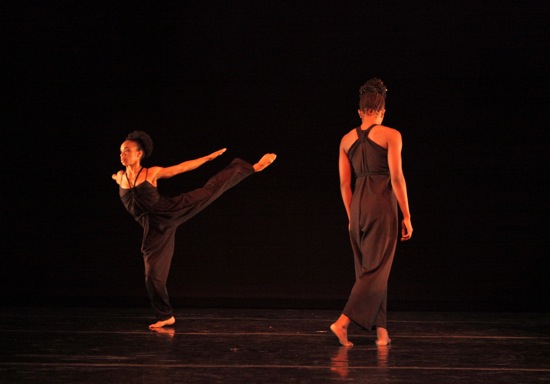
Annique Roberts (L) and Coral Dolphin in “March” from Ronald K. Brown’s Lesson. Photo: Ayodele Casel
In excerpts from the 1995 Lessons: Exotica & March, the performers wear black clothes for “March”, and later, velvet ones in jewel tones for “Exotica” (designs by Omotayo Wunmi Olaiya). The choreography expresses a solidarity that is social and political as well as spiritual. Strength of spirit guides the dance too, and God, at one point, is referred to as “She” in a rendition of the 23rd Psalm. Before the gospel music of Charles H. Gabriel and Civilla D. Martin begins, though, and some time before the electronic work of the Ananda Project and DK MKL starts up, the dancers occasionally raise one arm in solidarity, and move to one of Martin Luther King Jr.’s speeches, in which he speaks of the need for peace, for brotherhood, and for equality with the scorching fervor of a preacher. As in many of his speeches, he quotes John Donne:
“No man is an island,
Entire of itself,
Every man is a piece of the continent,
A part of the main. . . .
Any man’s death diminishes me,
Because I am involved in mankind. . . .”
It is to his sonorous voice that Roberts and Dolphin dance together as sisters or mother and child or comrades—moving in unison, looking at each other for guidance., cartwheeling with bent legs. Later, they with embrace, or one carries the other. Riley and Cabuag, too, lift each other. Caldwell dances with the company’s three men; she also lies on top of the fallen Young, perhaps shielding her, and then backs off the stage, gesturing as if to wash her hands. Thoulouis strides toward us on a path of light.
The program ends with Grace (made by Brown for the Alvin Ailey American Dance Theater and revised for his own company in 2003). For this fine piece, the music is by Duke Ellington, Roy Davis, Jr., and Fela Anikulapo Kuti. Ellington’s “Come Sunday” (“Lord, dear Lord above, God almighty, God of love, Please look down and see my people through.”) begins and ends Grace. Young, in white, appears through the opening in the back curtains, beyond which a bright sky can be seen (original lighting by William H. Grant recreated by Brenda Gray). This beautiful woman is the serene leader of this community, yet she can also lash her arms rapidly and jitter and sink into deep positions with the sweet freedom of one who’s at home in the body God gave her.
The dancers pay attention to her and to one another. For the first time in the evening, Brown joins his company members, and they watch while he dances in his inimitably loose, full-bodied style. Young marshals Roberts and Edmundson, Dolphin joins, Caldwell returns, and all five women dance. Now you start to wonder why Young and Caldwell wear white and the other three are dressed in red. There are those differences among the men too.
The color scheme is a clue to something that isn’t really evident in the dancing. Whatever the hue of their clothing, these people move alike. When Cabuag has finished performing (wonderfully) a solo, all return garbed in white, as if Brown wants us to see them as redeemed. But there are no “wicked ways” that we can see need redeeming (this has an upside: no melodramatic strayers acting out an aversion to righteousness). Just before the end, though,Young grabs Thoulounis and gives him a quick little lesson, as if he were in danger of backsliding. Enigmas like this make me feel that Brown is more gifted at creating detailed, lucid designs than clarifying the overall gist of his pieces. And, of course, he’s brilliant at making movement that attacks you as you watch it—pummels you, strokes you, elates you, and makes you want to get up onstage and sweat your way to glory with the dancers.

